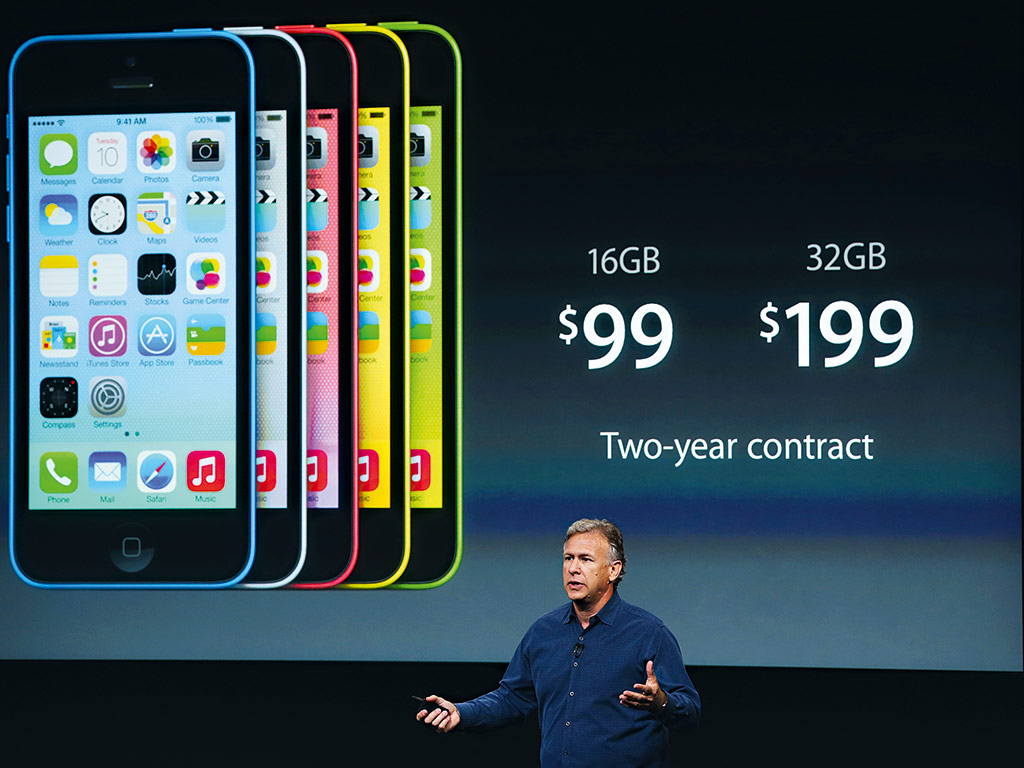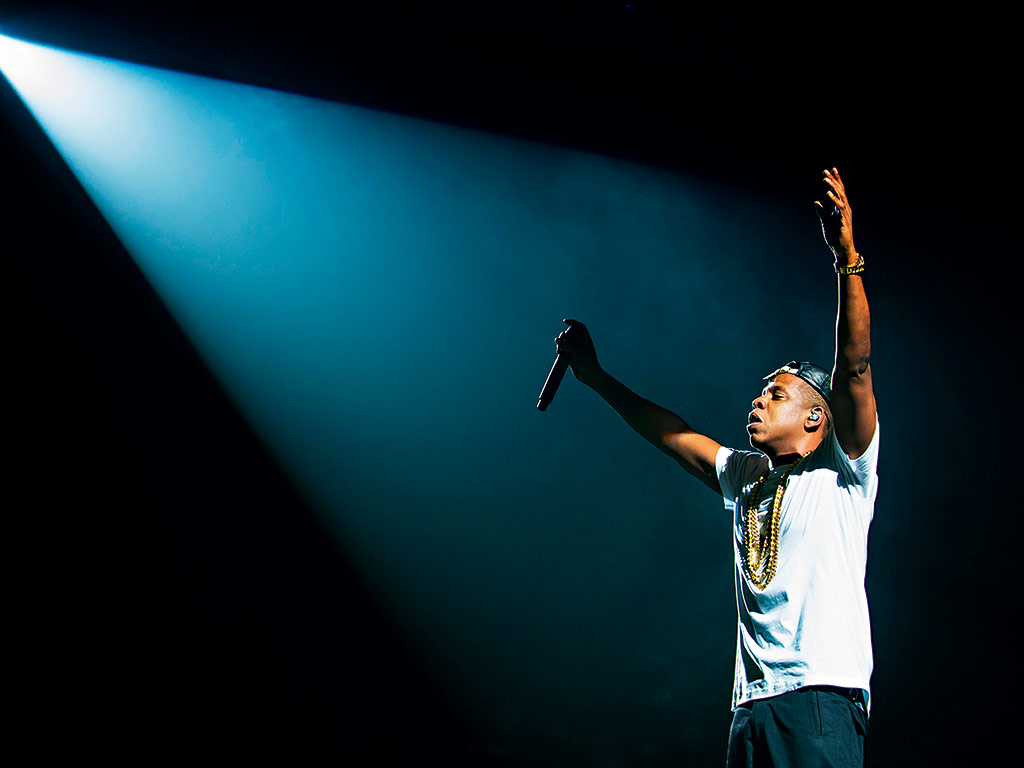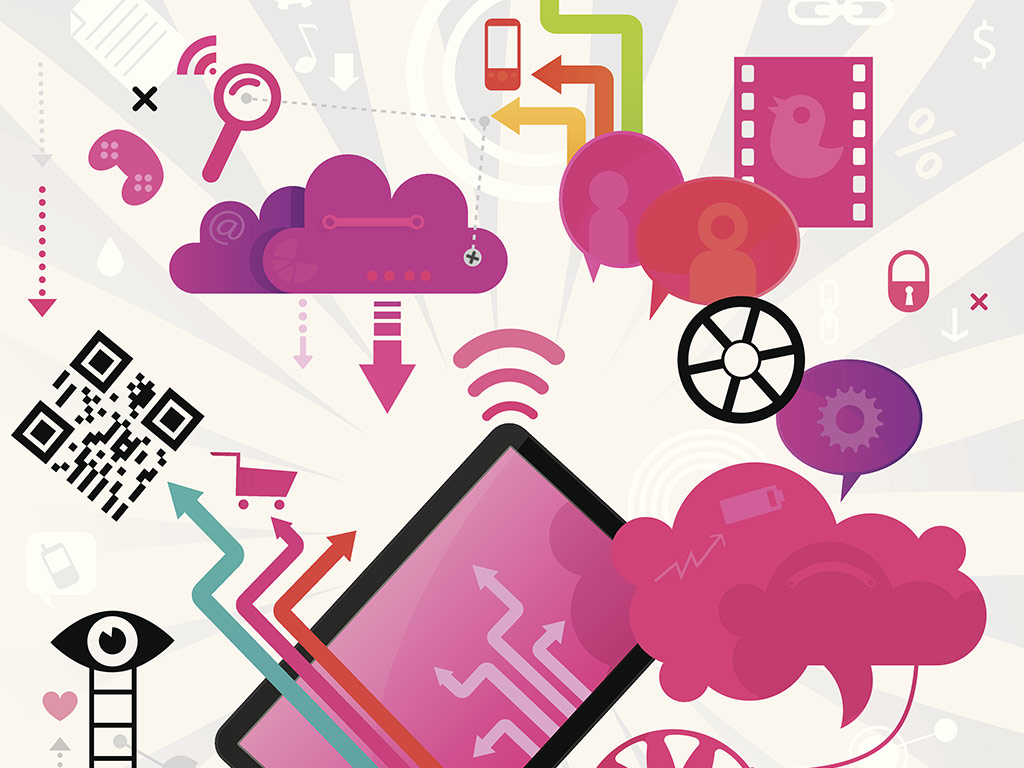Smart marketing: losing money to make money
Make the customer spend more by making them think they’re spending less. Used correctly, loss leaders are a brilliant business ploy

Apple Senior Vice President of Worldwide Marketing, Phil Schiller, speaks about the new iPhone 5C. Customers who choose not to buy an iPhone outright will end up spending an average of 32 percent more in the long run
Last year, rapper Jay-Z became the first artist in history to go platinum without releasing a single track from his latest album, after striking a monumental deal with Samsung. The tech giant agreed to purchase one million copies of Jay-Z’s highly anticipated album, Magna Carta Holy Grail, for a discount price of $5 each. The company was then able to offer its mobile customers the opportunity to download Jay-Z’s album 72 hours before its official release date (free of charge) on an app available exclusively to Samsung Galaxy users.
Magna Carta Holy Grail

$1m
Number of digital copies Samsung bought prior to the album’s release
$5m
Amount Samsung paid Jay-Z so it could make his album available early
$12bn
Samsung’s annual global marketing budget
500,000
Galaxy customers who downloaded the exclusive app
Around 500,000 took up the offer – and after expenditures generated from advertising the release, Samsung lost well over $5m. With a global marketing budget of over $12bn, there’s a good chance no one at the tech giant really cares. By using Jay-Z’s popular sound as a loss leader, Samsung took yet another step towards expanding its brand identity as one that is young, fun and culturally relevant. That gain is essentially priceless.
“What we’re seeing today is a marketing battle between giants, and music has become one of many pawns in that struggle,” says Benedict Evans of Enders Analysis. “Samsung is happy to give away any number of commodities if it means gaining more leverage as a brand.”
By no means is Samsung the sole innovator in the field. Loss leaders have been used in business models for decades. Only over the past several years, however, have global industries found them a fundamental tool with which to differentiate their products and services from their otherwise indistinguishable competitors.
The idea is quite straightforward: by choosing to offer one product at a loss, companies are able to subtly (or not-so-subtly) guide consumers towards purchasing other goods at full price. Businesses may implement the strategy to reach a higher volume of overall sales, or as a means of aggressively expanding a small customer base.
Loss leaders can also be used as a marketing ploy to inform customers of a new brand, or to simply remind them of an existing one. They promote different brands within the same corporate family and encourage consumers to alter their buying habits by trying something new. More importantly, loss leaders build and expand upon a critical mass of followers, and convince those customers to buy into separate parts of one system. The strategy poses many risks to businesses big and small, but if deployed correctly, loss leaders can blast sales through the roof.
The best a man can get
The concept of loss leaders as a business model has been around for over a century – having been first implemented by the magnificently named King Camp Gillette. At the turn of the 20th century, Gillette noticed a gap in the market for razorblades that didn’t require any sharpening or upkeep. After inventing his first disposable razor in 1903, the entrepreneur faced dismal sales. But instead of giving up, Gillette came up with a different sales tactic: he discovered he could earn more revenue from buyers on a more frequent basis by giving away his razor handles absolutely free, but continuing to charge for the disposable blades.
Gillette razors were handed out en masse as promotional tools at banks and grocery stores, under the risky presumption that the loss of one part of a multi-part system would lead new users to become repeat customers. The gamble paid off and Gillette’s brand became a global institution – as Adrien Brody and André 3000 can contractually attest.
A broken system
Fast-forward 111 years, and loss leaders are deployed by thousands of companies every day with the aim of marketing brands into serious profit. In the gaming industry, they’re ubiquitous. Sony loses an estimated six cents on the dollar for every Playstation 3 console it manufactures. Microsoft loses even more on its Xbox 360. When the system was first introduced in 2005, Microsoft sold each Xbox for $399, even though it costs $525 to put each one together (not including labour). The retail cost of an Xbox has since dropped, creating an even larger production deficit.
Xbox 360

$399
Original retail price
$525
Cost paid by Microsoft for parts (labour not included)
$60
Price of a new Xbox 360 game
48m
Number of gamers who subscribe to Xbox Live, a $5/month online service
But Microsoft makes back every penny through the sale of games, additional hardware and subscriptions to its online service. For each $60 game sold, Microsoft makes $7 in royalties. It’s been estimated the average gamer purchases a new title every two months. That means, over the course of five years, Microsoft makes $576 off each customer on games alone. Add in a supplement of $5 per month from the 48 million gamers who pay to use Microsoft’s Xbox Live service, and the money lost manufacturing each console is only a distant memory.
It also helps that tech giants such as Microsoft and Sony have interests in multiple industries, and can therefore afford to lose money on one or two ventures. But by using technologically advanced consoles as loss leaders, both companies are perpetuating the rise of a $25bn-a-year industry.
Sales inferno
Supermarkets exploit this strategy in a different way. Perishable foods such as milk are sold at below market value as a means of drawing customers into the store. Retailers have been accused of damaging the dairy industry by making wholesale prices unnecessarily competitive, but it doesn’t stop with milk. Cheap music, DVDs and books are used to manipulate customers into spending a gratuitous amount of money on other goods.
Sainsbury’s, for example, sold Dan Brown’s most recent novel, Inferno, to customers for a mere £6 on the condition they spent over £30 elsewhere in the store. By selling the book at 70 percent under its suggested retail price – and several pounds under wholesale price – Sainsbury’s technically lost money on the promotion. But the chain simultaneously gained a flurry of shoppers anxious to get their hands on a best-selling author’s discounted book.
Similar to the cutthroat competition Samsung faces in the mobile industry, supermarkets such as Sainsbury’s and Tesco are forced to battle with each other on a daily basis. Producers often fan the flames further still by engaging in predatory pricing in a bid to beat the competition – even though the practice is outlawed in most jurisdictions. Regardless, chains live and die by their effective use of loss leader promotions and bend over backwards to attract consumers with a few low-priced products that will lead to a full shopping trolley.
While tech manufacturers such as Samsung are able to exploit commodities such as music in order to sell products, mobile providers use the products themselves as loss leaders. Virtually every service provider in operation today employs this strategy, from Verizon Wireless to EE. O2 in particular has experienced huge gains by using loss leaders.
Like many providers, at the point of sale O2 offers customers a choice between purchasing their phone outright, or receiving it free-of-charge (or heavily discounted) in return for taking on a slightly more expensive monthly plan. Customers who opt for the latter may enjoy short-term savings, but, in the long-term, O2 is the winner.
By choosing not to purchase an iPhone outright, customers will actually spend an average of 32 percent more over the course of their two-year contract period than those who opted against a free handset at the point of sale. Needless to say, the sales tactic has paid off; O2 sustained healthy growth in the first half of 2013, thanks to a 6.6 percent increase in its Apple-addicted customer base.
The social network
More recently, the mobile industry has taken a different approach to loss leaders by
relying on a ‘network effect’. By approaching loss leaders as part of a valuable network, developers give away products for free in order to reach and maintain a critical mass. That’s how the mobile app market has been able to expand so aggressively.
Free apps

$40bn
Apps downloaded from the iTunes store
90%
Percentage of apps downloaded for free
$1.2bn
Revenues made last year by Zynga, creator of free app Farmville
In January 2013, Apple announced its App Store had reached 40 billion unique downloads since it was launched in 2008. In 2012, 90 percent of the apps downloaded were offered free of charge. Bearing that in mind, it’s difficult to imagine how businesses interested in commissioning their own apps could ever hope to make any money from the endeavour.
Yet by using an app as a loss leader, developers actually make quite a lucrative return. After offering apps and games for free, producers are subsequently able to cash in with a mixture of advertising and the sale of virtual goods – such as extra lives in games, or particularly tasty recipes in one of Jamie Oliver’s dozens of kitchen apps. Even if the tiniest fraction of an app’s audience opts to buy some of these virtual goods, the results can be astounding.
“As long as the app is perceived as free for the consumer then the marketability of the app is generally 50 times higher than any paid app,” says Iljar Laurs, founder of the world’s largest free app store, GetJar. The art of using an app as a loss leader was perfected in 2012 by California-based web developer Zynga, whose pioneering app Farmville helped it post revenues of over $1.2bn.
After giving away the game free of charge, Zynga offered addicted customers the ability to purchase virtual enhancements for their simulated online farms using very real credit card details. Although the tactic sparked outrage among parents whose children unknowingly racked up hundreds of pounds in bills on the game, Zynga’s creation undeniably epitomises the potential of loss leaders.
Don’t run out of chicken
There are inevitably dangers associated with using loss leaders – all of which stem back to whether companies opt to perform adequate market research prior to taking the plunge. In 2009, for example, American fast-food joint Popeye’s failed to do its research before advertising an eight-peice chicken special for $4.99. The deal sent customers flocking to the chain. Unfortunately, Popeye’s hadn’t expected to see numbers of such magnitude.
By lunchtime, its restaurants had completely run out of chicken. They had to turn customers away hungry – which didn’t go down well. Angry diners phoned the police on the basis of false advertising and vented their frustrations to the national media. While sales may have been bolstered for a few hours that morning, the negative media attention ultimately hurt Popeye’s.
Companies considering using loss leaders would do well to crunch the numbers before giving away the farm. Small businesses attempting to attract customers tend to mark items far too low, to the point where not even the draw power of loss leaders can offset the money lost on promotions. Loss leaders also attract entire networks of deal hunters who have absolutely no intention of buying anything in the store other than the low-priced items in question. Companies end up practically giving away items without seeing noticeable returns.
Above all else, the success of a loss leader’s campaign rests upon a business’s ability to develop an in-depth knowledge of its market, competitors and consumer needs. For tech giants such as Samsung – whose marketing department enjoys a monolithic £12bn budget – minor miscalculations bear few repercussions. Smaller businesses, on the other hand, must tread carefully.
When used correctly, loss leaders are a powerful business tool. They bring in new and former customers alike, and can break longstanding brand ties so that customers. That power is invaluable – and with this business tool on the rise, the survival of many brands will continue to rest heavily on their ability to successfully employ loss leaders.













